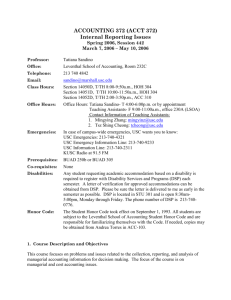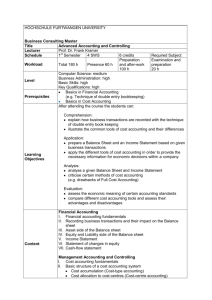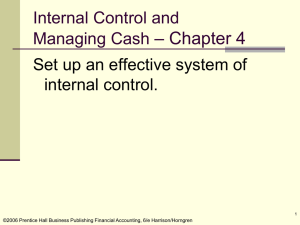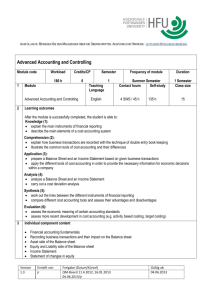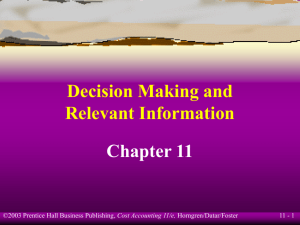Pricing Decisions and Cost Management Chapter 12
advertisement
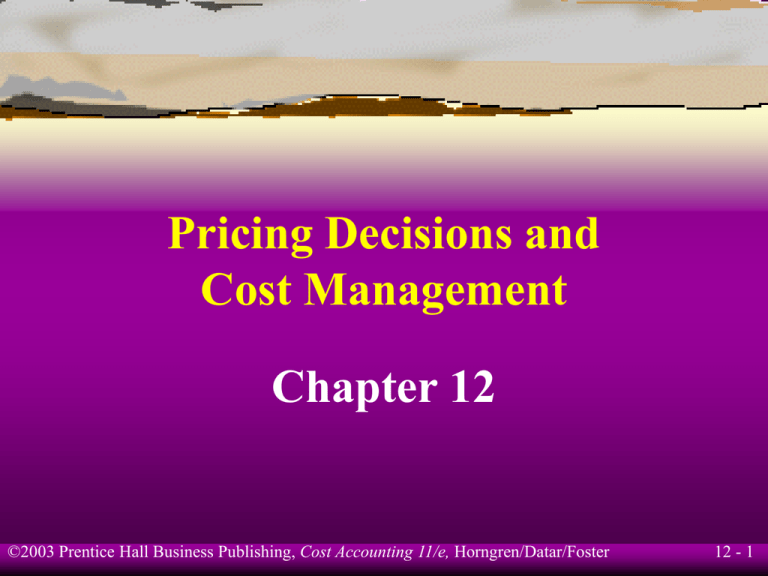
Pricing Decisions and Cost Management Chapter 12 ©2003 Prentice Hall Business Publishing, Cost Accounting 11/e, Horngren/Datar/Foster 12 - 1 Learning Objective 1 Discuss the three major influences on pricing. ©2003 Prentice Hall Business Publishing, Cost Accounting 11/e, Horngren/Datar/Foster 12 - 2 Major Influences on Pricing Decisions Customers influence prices through their effect on demand. Competitors influence prices through their actions. Costs influence prices because they affect supply. ©2003 Prentice Hall Business Publishing, Cost Accounting 11/e, Horngren/Datar/Foster 12 - 3 Learning Objective 2 Distinguish between short-run and long-run pricing decisions. ©2003 Prentice Hall Business Publishing, Cost Accounting 11/e, Horngren/Datar/Foster 12 - 4 Time Horizon of Pricing Decisions Short-run decisions have a time horizon of less than a year: pricing a one-timeonly special order adjusting product mix and output volume Long-run decisions involve a time horizon of a year or longer: pricing a product in a major market where price setting has some leeway ©2003 Prentice Hall Business Publishing, Cost Accounting 11/e, Horngren/Datar/Foster 12 - 5 Time Horizon of Pricing Decisions 1. Costs that are often irrelevant for short-run pricing decisions (fixed costs) are often relevant in the long run. 2. Profit margins in long-run pricing decisions are often set to earn a reasonable return on investment. ©2003 Prentice Hall Business Publishing, Cost Accounting 11/e, Horngren/Datar/Foster 12 - 6 Costing and Pricing for the Short Run – Example Lomas Corporation operates a plant with a monthly capacity of 500,000 cases of tomato sauce. Lomas is presently producing 300,000 cases per month. Del Valle has asked Lomas and two other companies to bid on supplying 150,000 cases each month for the next four months. ©2003 Prentice Hall Business Publishing, Cost Accounting 11/e, Horngren/Datar/Foster 12 - 7 Costing and Pricing for the Short Run – Example Cost Per Case Variable manufacturing Variable marketing and distribution Fixed manufacturing Fixed marketing and distribution Total ©2003 Prentice Hall Business Publishing, Cost Accounting 11/e, Horngren/Datar/Foster $38 13 14 15 $80 12 - 8 Costing and Pricing for the Short Run – Example If Lomas makes the extra 150,000 cases, the existing total fixed manufacturing overhead ($4,200,000 per month) would continue, plus an additional $165,000 of fixed overhead will be incurred per month. Total fixed marketing and distribution costs will not change. What price should Lomas bid? ©2003 Prentice Hall Business Publishing, Cost Accounting 11/e, Horngren/Datar/Foster 12 - 9 Costing and Pricing for the Short Run – Example Relevant Costs Variable manufacturing Fixed manufacturing Total $38.00 1.10 $39.10 $165,000 ÷ 150,000 = $1.10 Any bid above $39.10 will improve Lomas’s profitability in the short run. ©2003 Prentice Hall Business Publishing, Cost Accounting 11/e, Horngren/Datar/Foster 12 - 10 Costing and Pricing for the Short Run – Example Suppose that Lomas believes that Del Valle will sell the tomato sauce in Lomas’s current markets but at a lower price than Lomas. Relevant costs of the bidding decision should include revenues lost on sales to existing customers. ©2003 Prentice Hall Business Publishing, Cost Accounting 11/e, Horngren/Datar/Foster 12 - 11 Costing and Pricing for the Long Run – Example Latisha Computer Corporation manufactures two brands of computers: Simple Computer (SC) and Complex Computer (CC). Latisha uses a long-run time horizon to price Complex Computer (CC). ©2003 Prentice Hall Business Publishing, Cost Accounting 11/e, Horngren/Datar/Foster 12 - 12 Costing and Pricing for the Long Run – Example Direct materials costs vary with the number of units produced. Direct manufacturing labor costs vary with direct manufacturing labor-hours. Ordering and receiving, testing and inspection, and rework costs vary with their chosen cost drivers. ©2003 Prentice Hall Business Publishing, Cost Accounting 11/e, Horngren/Datar/Foster 12 - 13 Costing and Pricing for the Long Run – Example Ordering: $78 per order Testing: $ 2 per inspection hour Rework: $38 per unit reworked Cost per Unit Direct materials $450.00 Direct labor: 3.50 hours @ $19 per hour 66.50 Total $516.50 ©2003 Prentice Hall Business Publishing, Cost Accounting 11/e, Horngren/Datar/Foster 12 - 14 Costing and Pricing for the Long Run – Example Number of orders placed: 17,000 Number of testing hours: 3,000,000 Number of units reworked: 8,000 The direct fixed costs of machines used exclusively for the manufacture of Complex Computer total $7,000,000. What is the cost of producing 100,000 units of Complex Computer? ©2003 Prentice Hall Business Publishing, Cost Accounting 11/e, Horngren/Datar/Foster 12 - 15 Costing and Pricing for the Long Run – Example Direct material and labor $51,650,000 Direct fixed costs 7,000,000 Ordering (17,000 × $78) 1,326,000 Testing (3,000,000 × $2) 6,000,000 Rework (8,000 × $38) 304,000 Total $66,280,000 $66,280,000 ÷ 100,000 units = $662.80/unit ©2003 Prentice Hall Business Publishing, Cost Accounting 11/e, Horngren/Datar/Foster 12 - 16 Alternative Long-Run Pricing Approaches Market-based Cost-based (also called cost-plus) ©2003 Prentice Hall Business Publishing, Cost Accounting 11/e, Horngren/Datar/Foster 12 - 17 Learning Objective 3 Price products using the target-costing approach. ©2003 Prentice Hall Business Publishing, Cost Accounting 11/e, Horngren/Datar/Foster 12 - 18 Target Price and Target Cost Target price is the estimated price for a product (or service) that potential customers will be willing to pay. Target Price – Target operating income per unit = Target cost per unit ©2003 Prentice Hall Business Publishing, Cost Accounting 11/e, Horngren/Datar/Foster 12 - 19 Target Price and Target Cost Steps in developing target prices and target costs: 1. Develop a product that satisfies the needs of potential customers. 2. Choose a target price. 3. Derive a target cost per unit. 4. Perform value engineering to achieve target costs. ©2003 Prentice Hall Business Publishing, Cost Accounting 11/e, Horngren/Datar/Foster 12 - 20 Implementing Target Pricing and Target Costing Latisha’s management wants a 15% target operating income on sales revenues of CC. Target sales revenue is $750 per unit. What is the target cost per unit? $750 × .15 = $112.50, $750 – $112.50 = $637.50 Current full cost per unit of CC is $662.80 ©2003 Prentice Hall Business Publishing, Cost Accounting 11/e, Horngren/Datar/Foster 12 - 21 Implementing Target Pricing and Target Costing Value engineering is a systematic evaluation of all aspects of the value-chain business function with the objective of reducing costs. ©2003 Prentice Hall Business Publishing, Cost Accounting 11/e, Horngren/Datar/Foster 12 - 22 Value-Added Costs A value-added cost is a cost that customers perceive as adding value, or utility, to a product or service: Adequate memory Pre-loaded software Reliability Easy-to-use keyboards ©2003 Prentice Hall Business Publishing, Cost Accounting 11/e, Horngren/Datar/Foster 12 - 23 Nonvalue-Added Costs A nonvalue-added cost is a cost that customers do not perceive as adding value, or utility, to a product or service. Cost of expediting Rework Repair ©2003 Prentice Hall Business Publishing, Cost Accounting 11/e, Horngren/Datar/Foster 12 - 24 Learning Objective 4 Apply the concepts of cost incurrence and locked-in costs. ©2003 Prentice Hall Business Publishing, Cost Accounting 11/e, Horngren/Datar/Foster 12 - 25 Cost Incurrence This describes when a resource is sacrificed or forgone to meet a specific objective. Research and development Design Manufacturing Marketing Distribution Customer support ©2003 Prentice Hall Business Publishing, Cost Accounting 11/e, Horngren/Datar/Foster 12 - 26 Locked-in Costs These are those costs that have not yet been incurred but which, based on decisions that have already been made, will be incurred in the future (designed-in costs). It is difficult to alter or reduce costs that are already locked in. ©2003 Prentice Hall Business Publishing, Cost Accounting 11/e, Horngren/Datar/Foster 12 - 27 Cumulative Costs per Unit Cost Incurrence and Locked-in Costs Value-Chain Functions R&D and Design Manufacturing Mkt., Dist., & Cust. Svc. ©2003 Prentice Hall Business Publishing, Cost Accounting 11/e, Horngren/Datar/Foster 12 - 28 Cost Incurrence and Locked-in Costs At the end of the design stage, direct materials, direct manufacturing labor, and many manufacturing, marketing, distribution, and customer-service costs are all locked in. ©2003 Prentice Hall Business Publishing, Cost Accounting 11/e, Horngren/Datar/Foster 12 - 29 Cost Incurrence and Locked-in Costs When a sizable fraction of the costs are locked in at the design stage, the focus of value engineering is on making innovations and modifying designs at the product design stage. ©2003 Prentice Hall Business Publishing, Cost Accounting 11/e, Horngren/Datar/Foster 12 - 30 Learning Objective 5 Price products using the cost-plus approach. ©2003 Prentice Hall Business Publishing, Cost Accounting 11/e, Horngren/Datar/Foster 12 - 31 Cost-Plus Pricing The general formula for setting a cost-based price is to add a markup component to the cost base. Cost base $ X Markup component Y Prospective selling price $X + Y ©2003 Prentice Hall Business Publishing, Cost Accounting 11/e, Horngren/Datar/Foster 12 - 32 Cost-Plus Pricing Assume that Latisha’s engineers have redesigned CC into CCI at a new cost of $637.50. The company desires a 20% markup on the full unit cost. What is the prospective selling price? ©2003 Prentice Hall Business Publishing, Cost Accounting 11/e, Horngren/Datar/Foster 12 - 33 Cost-Plus Pricing Cost base: Markup component: (637.50 × .20) Prospective selling price: ©2003 Prentice Hall Business Publishing, Cost Accounting 11/e, Horngren/Datar/Foster $637.50 127.50 $765.00 12 - 34 Cost-Plus Pricing Assume that the capital investment needed for CCI is $75 million, and the company (pretax) target rate of return on investment is 17%. What is the target annual operating income that Latisha needs to earn from CCI? $75,000,000 × .17 = $12,750,000 ©2003 Prentice Hall Business Publishing, Cost Accounting 11/e, Horngren/Datar/Foster 12 - 35 Cost-Plus Pricing What is the target operating income per unit? $12,750,000 ÷ 100,000 units = $127.50/unit ©2003 Prentice Hall Business Publishing, Cost Accounting 11/e, Horngren/Datar/Foster 12 - 36 Cost-Plus Pricing The 17% target rate of return on investment expresses the company’s expected annual operating income as a percentage of investment. The 20% markup expresses operating income per unit as a percentage of the full product cost per unit. ©2003 Prentice Hall Business Publishing, Cost Accounting 11/e, Horngren/Datar/Foster 12 - 37 Advantages of Using Full Costs Full recovery of all costs of the product Price stability Simplicity ©2003 Prentice Hall Business Publishing, Cost Accounting 11/e, Horngren/Datar/Foster 12 - 38 Alternative Cost-Plus Methods Variable manufacturing costs Variable costs of the product Manufacturing function costs ©2003 Prentice Hall Business Publishing, Cost Accounting 11/e, Horngren/Datar/Foster 12 - 39 Learning Objective 6 Use life-cycle budgeting and costing when making pricing decisions. ©2003 Prentice Hall Business Publishing, Cost Accounting 11/e, Horngren/Datar/Foster 12 - 40 Life-Cycle Budgeting The product life cycle spans the time from original research and development, through sales, to when customer support is no longer offered for that product. A life-cycle budget estimates revenues and costs of a product over its entire life. ©2003 Prentice Hall Business Publishing, Cost Accounting 11/e, Horngren/Datar/Foster 12 - 41 Life-Cycle Budgeting Features that make life-cycle budgeting important: Nonproduction costs Development period for R&D and design Other predicted costs ©2003 Prentice Hall Business Publishing, Cost Accounting 11/e, Horngren/Datar/Foster 12 - 42 Nonproduction Costs These costs are less visible on a product-by-product basis. When nonproduction costs are significant, identifying these costs by product is essential for target pricing, target costing, value engineering, and cost management. ©2003 Prentice Hall Business Publishing, Cost Accounting 11/e, Horngren/Datar/Foster 12 - 43 Development Period When a high percentage of total life-cycle costs are incurred before any production begins and before any revenues are received, it is crucial for the company to have as accurate a set of revenue and cost predictions for the product as possible. ©2003 Prentice Hall Business Publishing, Cost Accounting 11/e, Horngren/Datar/Foster 12 - 44 Predicted Costs Many of the production, marketing, distribution and customer service costs are locked in during the R&D and design stage. Life-cycle budgeting facilitates value engineering at the design stage before costs are locked in. ©2003 Prentice Hall Business Publishing, Cost Accounting 11/e, Horngren/Datar/Foster 12 - 45 Life-Cycle Budgeting and Costing Consider a life-cycle average sales price of $55,000 per unit. If the desired life-cycle contribution is 45%, what is the allowable cost over the life cycle of the product? $55,000 – ($55,000 × .45) = $30,250 ©2003 Prentice Hall Business Publishing, Cost Accounting 11/e, Horngren/Datar/Foster 12 - 46 Learning Objective 7 Describe two pricing practices in which noncost factors are important when setting prices. ©2003 Prentice Hall Business Publishing, Cost Accounting 11/e, Horngren/Datar/Foster 12 - 47 Other Considerations in Pricing Decisions Price discrimination Peak-load pricing ©2003 Prentice Hall Business Publishing, Cost Accounting 11/e, Horngren/Datar/Foster 12 - 48 Learning Objective 8 Explain the effects of antitrust laws on pricing. ©2003 Prentice Hall Business Publishing, Cost Accounting 11/e, Horngren/Datar/Foster 12 - 49 Price Discrimination Laws Under the U.S. Robinson-Patman Act, a manufacturer cannot price-discriminate between two customers if the intent is to lessen or prevent competition for customers. ©2003 Prentice Hall Business Publishing, Cost Accounting 11/e, Horngren/Datar/Foster 12 - 50 Price Discrimination Laws They apply to manufacturers, not service providers. Price discrimination is permissible if differences in prices can be justified by differences in costs. ©2003 Prentice Hall Business Publishing, Cost Accounting 11/e, Horngren/Datar/Foster 12 - 51 Price Discrimination Laws Predatory pricing occur when… …the predator company charges a price that is below an appropriate measure of its costs, and …the predator company has a reasonable prospect of recovering in the future the money it lost by pricing below cost. ©2003 Prentice Hall Business Publishing, Cost Accounting 11/e, Horngren/Datar/Foster 12 - 52 Price Discrimination Laws Most courts in the United States have defined the “appropriate measure of costs” as the short-run marginal and average variable costs. ©2003 Prentice Hall Business Publishing, Cost Accounting 11/e, Horngren/Datar/Foster 12 - 53 Price Discrimination Laws Dumping occurs when a non-U.S. company sells a product in the United States at a price below the market value in the country of its creation, and its action injures an industry in the United States. ©2003 Prentice Hall Business Publishing, Cost Accounting 11/e, Horngren/Datar/Foster 12 - 54 Price Discrimination Laws Collusive pricing occurs when companies in an industry conspire in their pricing and output decisions to achieve a price above the competitive price. ©2003 Prentice Hall Business Publishing, Cost Accounting 11/e, Horngren/Datar/Foster 12 - 55 End of Chapter 12 ©2003 Prentice Hall Business Publishing, Cost Accounting 11/e, Horngren/Datar/Foster 12 - 56
